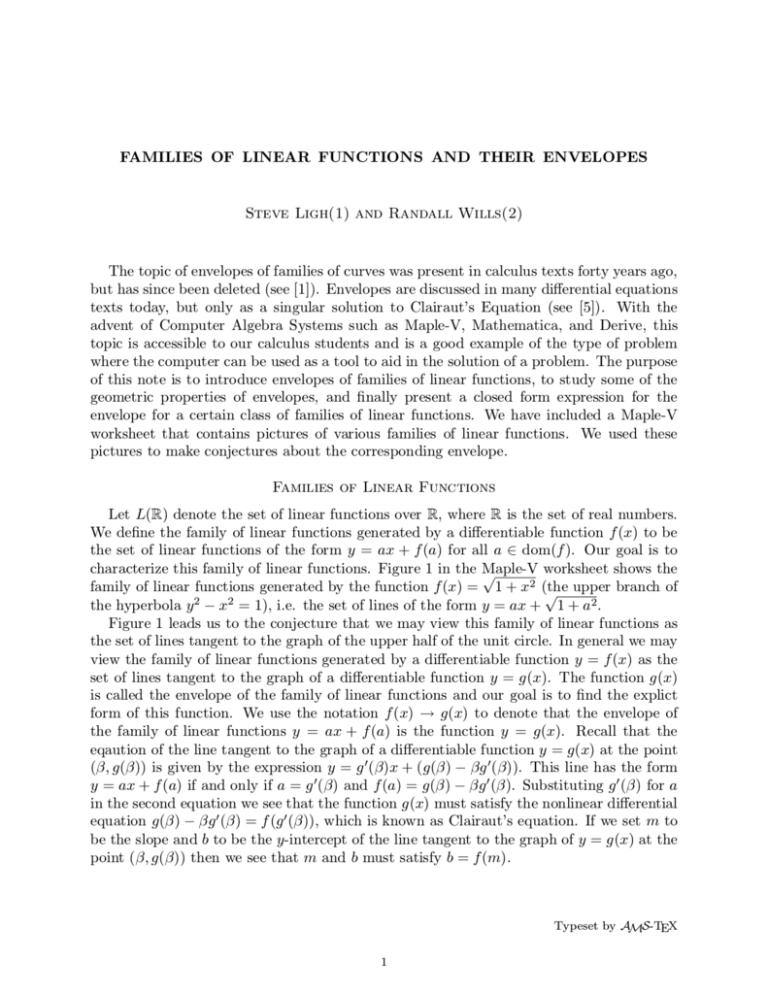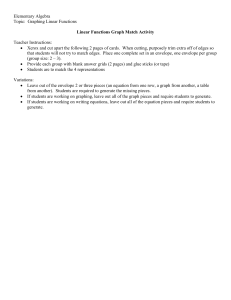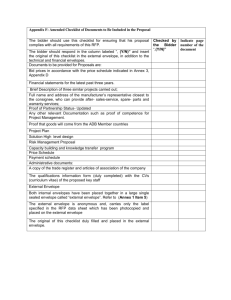FAMILIES OF LINEAR FUNCTIONS AND THEIR ENVELOPES Steve
advertisement

FAMILIES OF LINEAR FUNCTIONS AND THEIR ENVELOPES
Steve Ligh(1) and Randall Wills(2)
The topic of envelopes of families of curves was present in calculus texts forty years ago,
but has since been deleted (see [1]). Envelopes are discussed in many di®erential equations
texts today, but only as a singular solution to Clairaut's Equation (see [5]). With the
advent of Computer Algebra Systems such as Maple-V, Mathematica, and Derive, this
topic is accessible to our calculus students and is a good example of the type of problem
where the computer can be used as a tool to aid in the solution of a problem. The purpose
of this note is to introduce envelopes of families of linear functions, to study some of the
geometric properties of envelopes, and ¯nally present a closed form expression for the
envelope for a certain class of families of linear functions. We have included a Maple-V
worksheet that contains pictures of various families of linear functions. We used these
pictures to make conjectures about the corresponding envelope.
Families of Linear Functions
Let L(R ) denote the set of linear functions over R , where R is the set of real numbers.
We de¯ne the family of linear functions generated by a di®erentiable function f(x) to be
the set of linear functions of the form y = ax + f(a) for all a 2 dom(f). Our goal is to
characterize this family of linear functions. Figure 1 in the Maple-V
worksheet shows the
p
family of linear functions generated by the function f(x) = 1 + x2 (the
p upper branch of
2
2
the hyperbola y ¡ x = 1), i.e. the set of lines of the form y = ax + 1 + a2.
Figure 1 leads us to the conjecture that we may view this family of linear functions as
the set of lines tangent to the graph of the upper half of the unit circle. In general we may
view the family of linear functions generated by a di®erentiable function y = f(x) as the
set of lines tangent to the graph of a di®erentiable function y = g(x). The function g(x)
is called the envelope of the family of linear functions and our goal is to ¯nd the explict
form of this function. We use the notation f(x) ! g(x) to denote that the envelope of
the family of linear functions y = ax + f(a) is the function y = g(x). Recall that the
eqaution of the line tangent to the graph of a di®erentiable function y = g(x) at the point
(¯; g(¯)) is given by the expression y = g 0(¯)x + (g(¯) ¡ ¯g 0(¯)). This line has the form
y = ax + f(a) if and only if a = g 0(¯) and f(a) = g(¯) ¡ ¯g0 (¯). Substituting g0 (¯) for a
in the second equation we see that the function g(x) must satisfy the nonlinear di®erential
equation g(¯) ¡ ¯g0 (¯) = f (g0 (¯)), which is known as Clairaut's equation. If we set m to
be the slope and b to be the y-intercept of the line tangent to the graph of y = g(x) at the
point (¯; g(¯)) then we see that m and b must satisfy b = f(m).
Typeset by AMS-TEX
1
2
STEVE LIGH(1) AND RANDALL WILLS(2)
Proposition 1. If f(x) =
p
1 + x2 and g(x) =
p
1 ¡ x2 then f (x) ! g(x):
Proof. By the discussion above, to show that f(x) ! g(x) we must show thatpthe slope m
and the y-intercept b of the
the graph of y = g(x) satisfy b = 1 + m2 (i.e.
p line tangent to
b = f (m)) Since g(x) = 1 ¡ x2 , then g0 (¯) = p¡¯ 2 and hence the equation of the line
1¡¯
tangent to the graph of y = g(x) at the point (¯; g(¯)) is given by y = p¡¯ 2 x + p
Thus m = p¡¯
1¡¯2
and b = p
1
1¡¯ 2
1¡¯
and it is clear that
Ã
f(m) = f
1
:
1¡¯ 2
p
¡¯
1 ¡ ¯2
!
v
!2
Ã
u
u
¡¯
t
= 1+ p
1 ¡ ¯2
=p
1
1 ¡ ¯2
= b:
Proposition 1 shows that the envelope of the family of linear functions generated by the
upper branch of the hyperbola y 2 ¡ x2 = 1 is the upper half of the unit circle. A straight
forward calculation shows that the envelope of the family of linear functions generated by
the lower branch of the hyperbola y2 ¡ x2 = 1 is the lower half of the unit circle. A natural
question to ask is whether the envelope of a family of linear functions generated by an
arbitrary hyperbola with major axis parallel to the y-axis is a circle or an ellipse.
The Effect that Translations and
Dilations of f(x) have on the Envelope g(x)
Before answering the question posed above we will de¯ne what we mean by translations
and dilations of a function f (x). For a more complete disscussion see [2].
(1) The graph of y = f(x) + E is a vertical translation of the graph of y = f (x).
(2) The graph of y = f(x + C) is a horizontal translation of the graph of y = f (x).
(3) The graph of y = Af (x) is a vertical dilation of the graph of y = f(x).
(4) The graph of y = f(Bx) is a horizontal dilation of the graph of y = f (x).
Every hyperbola whose major axis is parallel to the y-axis can be expressed in the
2
2
form (y¡k)
¡ (x¡h)
= 1. Solving for y we see that the hyperbola may be described
b2
a2
p
p
by the two functions y = § ab a2 + (x ¡ h)2 + k. Setting f(x) = 1 + x2 we see that
y = §bf( a1 x ¡ ha ) + k. Thus we see that this hyperbola can be expressed as translations
p
and dilations of f(x) = 1 + x2 . If we could understand the e®ect that translations and
dilations of f(x) have on the envelope g(x) then we could answer the question posed above.
In other words an understanding of the e®ect that translations and dilations of f (x) have
on g(x) would allow us to use a single result (f(x) ! g(x)) such as in Proposition 1 to
obtain a whole family of related results. In [2] we proved the following result.
Theorem 1. Suppose f(x) ! g(x), and let F(x) = Af (Bx + C) + Dx + E, and G(x) =
1
D
CD
Ag( AB
x + AB
)¡ C
B x ¡ B + E where A,B,C,D,E 2 R and A,B 6= 0. Then F (x) ! G(x).
We will now use Proposition 1 and Theorem 1 to ¯nd the envelope of the family of
linear functions generated by a hyperbola whose major axis is parallel to the y-axis. By
FAMILIES OF LINEAR FUNCTIONS AND THEIR ENVELOPES
3
p
p
Proposition 1 f (x) = 1 + x2 ! g(x) = 1 ¡ x2 and by the discussion above the hyperbola may be described by the two functions F (x) = §bf( 1b x ¡ ha ) + k. Applying Theorem
1 to F (x), we see that F(x) ! G(x) = §g(§ ab x) + hx + k. Simplifying we see that
p
p
G(x) = § b2 ¡ a2 x2 + hx + k. Let y = § b2 ¡ a2 x2 + hx + k, then if we eliminate
the radical we see that (h2 + a2 )x2 ¡ 2hxy + y2 + 2hkx ¡ 2ky + (k2 ¡ b2 ) = 0. Since
(¡2h)2 ¡ 4(h2 + a2 ) = ¡4a2 < 0 then this conic is a rotated ellipse (see [4]). Thus the
2
2
envelope of the family of linear functions generated by the hyperbola (y¡k)
¡ (x¡h)
= 1 is
b2
a2
indeed an ellipse. Figure 2 in the Maple-V worksheet shows the family of linear functions
(x¡2)2
= 1. According to the discussion above,
generated by the hyperbola (y ¡ 2)2 ¡ 4
p
p
1
2
F (x) = § 2 4 + (x ¡ 2) +2 ! G(x) = § 1 ¡ 4x2 +2x +2 and the envelope is the ellipse
8x2 ¡ 4xy + y 2 + 8x ¡ 4y + 3 = 0:
In [2] we showed more generally that the envelope of a family of linear functions generated by a conic section is again a conic section.
Explicit Form of the Envelope g(x) for a Certain Class of Functions f(x)
Given a di®erentiable function f(x), we saw earlier that the envelope, g(x), of the family
of linear functions generated by f(x) must satisfy Clairaut's equation, g(¯) ¡ ¯g0 (¯) =
f(g0 (¯)): In [3] we proved the following theorem which gives the explicit form of the
envelope g(x) for a certain class of functions f(x).
Theorem 2. Suppose that f(x) is a di®erentiable function such that f 0 (x) is injective.
f(x) ! g(x) if and only if g(x) = f ((f 0)¡1(¡x)) + x(f 0 )¡1 (¡x):
We will now use Theorem 2 to ¯nd the envelope of the family of linear functions whose
x and y intercepts are one unit apart. This family of linear functions is the set of linear
functions of the form xa + yb = 1 where a2 + b2 = 1. Rewriting this we see that the family
p
p
2
is the set of linear functions of the form y = ¨ 1¡a
x
§
1 ¡ a2 . Figure 3 in the Maple-V
a
worksheet shows this family of linear functions. Furthermore, this ¯gure suggests that the
envelope of this family of lines is a hypocycloid.
In order
to apply Theorem 2 we must rewrite the family in the form y = cx + f(x). Let
p
1¡a2
c = ¨ a and solving for a we see a = § pc12 +1 . Substituting, we see that the family is
q
q
2
c2
the set of linear functions of the form y = cx § c2 +1 . Let f(x) = x2x+1 then
r
0
f (x) =
x2 + 1
x
:
2
2
x
(x + 1)2
1
¡1
0
For x > 0 we see that f 0(x) = (x2 +1)
3=2 and for x < 0 we see that f (x) = (x2 +1) 3=2 and
Thus Theorem 2 applies. Aq
straight
that on each of these intervals f 0 (x) is injective.
q
2=3
2=3
forward calculation shows that (f 0 )¡1 (x) = 1¡x
for x > 0 and (f 0 )¡1 (x) = ¡ 1¡x
x2=3
x2=3
q
q
2=3
1¡x2=3
0 ¡1
for x < 0. Thus (f 0 )¡1(¡x) = ¡ 1¡x
for
x
>
0
and
(f
)
(¡x)
=
¡
for x < 0.
x2=3
x2=3
In both cases it can be shown that g(x) = f((f 0 )¡1 (¡x)) + x(f 0 )¡1 (¡x) = (1 ¡ x2=3 )3=2.
4
STEVE LIGH(1) AND RANDALL WILLS(2)
q
x2
Thus we have shown that
! (1 ¡ x2=3 )3=2 . Applying Theorem 2 we see that
x2 +1
q
2
¡ x2x+1 ! ¡(1 ¡ x2=3 )3=2. Let y = §(1 ¡ x2=3)3=2 , then eliminating the radical we see
that the envelope of the set of linear functions whose x and y intercepts are one unit apart
is the hypocycloid x2=3 + y 2=3 = 1.
References
1. W. L. Hart, Analytic Geometry and Calculus, D. C. Heath and Company, Boston, MA, 1957.
2. S. Ligh and R. Wills, On Linear Functions II, Mathematics and Computer Education 29 Number 1
(Winter 1995), 32{52.
3. S. Ligh and R. Wills, On Linear Functions III, submitted.
4. E. W. Swokowski, Calculus, 5th Ed., PWS-Kent Publishing Co. Boston MA, 1991.
5. D. G. Zill, A First Course in Di®erential Equations, 5th Ed., PWS-Kent Publishing Co., Boston MA,
1992.






